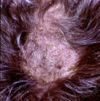Dermatophytosis
Jump to navigation
Jump to search
| This article is still under construction. |
|
|
- Dermatophytes in dermatophytosis
Dermatiaceous fungi are pigmented, saprophytic organisms - Phaeohyphomycetes
- They usually infect animals secondary to traumatic implantation of the organisms, and are therefore most often seen in subcuticular or cutaneous sites.
- In immunuocompromised hosts they may develop systemic infections.
Phaeohyphomycosis:
- It occurs sporadically in cats, horses, cattle, fish, reptiles, amphibians, and birds, and rarely in dogs.
Fungi implicated in animal phaeohyphomycosis include: Exophiala sp., Phialophora sp., Pseudomicrodochium sp., Bipolaris sp., Moniella sp., Cladosporium sp., Wangiella sp., Curvularia spp., Exserohilum sp., Alternaria sp., Staphylotrichum sp., and Xylohypha sp.
- Culture is necessary for definitive diagnosis.
- Caused by dermatophytes
- Microsporum - zoophilic
- Trichophyton - geophilic
- Epidermophyton - anthropophilic
- Common in many species, especially cats
- Hot, humid environment predisposes and viable fungi peripherally
- More common in young animals
- Produce proteolytic enzymes to penetrate surface lipid
- Fungal hyphae invade keratin -> break into arthrospores
- Epidermal hyperplasia (hyperkeratosis, parakeratosis, acanthosis) and inflammation
- Superficial perivascular dermatitis -> exocytosis (migration through epidermal layers) -> intracorneal microabscesses
- Exocytosis -> folliculitis -> furunculosis
- Highly variable lesions
- Normal -> eruptive nodular -> pseudomycetoma -> onychomycosis
- Grossly:
- Circular or irregular lesion, may coalesce
- Scaly to crusty patches
- Alopecia due to broken hair shafts and hairs lost from inflammed follicles
- Follicular papules and pustules
- Peripheral red ring (ringworm) due to dead fungi in areas of inflammation at centre of lesions and viable fungi peripherally
- Microscopically:
- Perifolliculitis, folliculitis or furunculosis
- Epidermal hyperplasia
- Intracorneal microabscesses
- Septate hyphae or spores may be found in stratum corneum and keratin of hair follicles


